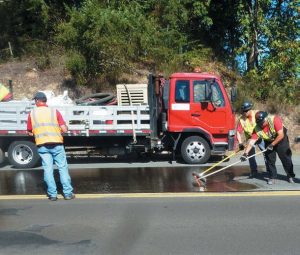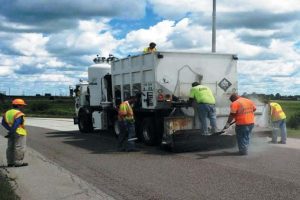Pavement Preservation Journal
Summer 2016, Vol. 9, No. 2
By Joseph Cheung and Frank Julian
The Federal Highway Administration and its many highway safety partners are addressing both infrastructure safety as well as driver performance issues. One element is to focus on the data and find roadway locations where severe crashes are overrepresented.
In 2013, there were approximately 5.6 million crashes reported across the nation, including 32,719 fatalities and more than 2.3 million injuries. More than half of the 2013 fatalities were roadway departure crashes.
Often, a small subset of the total highway network is responsible for a significant percentage of certain crash types. In 2008, for example, 28 percent of fatal crashes occurred on horizontal curves, yet horizontal curves make up only 5 percent of our nation’s roadways, which implies that crash fatalities that occur on curves are significantly overrepresented, and curves should be a specific area of focus for safety improvements.
Many states are making great efforts to improve safety on horizontal curves. Transportation agencies can work on a small percentage of curves and have a significant effect on highway safety if an effective countermeasure can be identified and applied. One of these countermeasures is the high friction surface treatment (HFST).
HIGH FRICTION SURFACE TREATMENTS
The innovative safety countermeasure that we call HFSTs began as a bridge deck preservation treatment in the U.S. in the 1950s. From there, it crossed the Atlantic and was adopted in the United Kingdom, where, in the late 1960s, it evolved into a safety treatment for curves and intersections. HFSTs came back to the United States in the late 1990s as a safety treatment for curves and intersections when some local and state agencies began to try a few installations. Although there was no official evaluation at the time, anecdotal evidence showed that the benefit was a phenomenal reduction in crashes; however, as discussed in FHWA’s Public Roads magazine, these early installations were not very durable. In fact, some installations failed immediately after installation.
The product did not seem to have consistency in either performance or in the specifications and methods used to apply the treatments. Early versions of HFSTs were being installed in the same way as a rigid bridge decking, varying by manufacturer’s guidance, or as a novelty product.
While bridge deck preservation installations are similar, they are also very different when applied on an asphalt pavement in a severe curve. The shear loads applied to the HFST aggregate are greater in curves than a typical concrete bridge deck, and asphalt pavement provides less tensile strength. Also, asphalt pavement as the bonding substrate has greater variation in the texture.
For years, the process for applying HFST was strictly a manual operation, with a squeegee application of the binder, followed by various methods for placing aggregate into the binder. While some contractors still pursue these methods, many have pursued technology innovation to improve quality and to shorten the application process.
One solution uses self-contained trucks that distribute the polymer evenly in a measured amount and instantly applies the aggregate. The equipment measures the amount of material applied and makes a project record of how much product was installed. So far, three different application equipment designs have been developed and are in production. This year, more contractors are entering the ranks of those with innovative equipment who have successfully bid projects.
SUBSTRATE PROVIDES STRENGTH
HFST can be placed on asphalt pavement or concrete surfaces, but it is not intended to be used for continuous paving. HFST is an extremely thin overlay, 0.12 to 0.16 in. (3 to 4 mm), that relies on the substrate on which it is placed for structural strength.
HFST consists of two parts: a polymer binder and a special aggregate. The special aggregate is extremely polish-resistant, very hard, and produces very high friction values (often in the 80 to 90 range FN40R when tested in accordance to AASHTO T 242).
The best aggregate to provide this performance is artificial aggregate—calcined bauxite—that is commonly used by the refractory industry and for creating industrial abrasives. The refractory-grade bauxite is heated (calcined) to between 1600 and 1800 deg C (2912 to 3272 deg F). Calcination transforms the soft clay bauxite into a product just slightly softer than diamonds on the Mohs hardness scale.
This product is also much more consistent in quality than naturally mined aggregates, and it requires special crushers to produce the required gradation from such an extremely hard substance. In addition, the calcined bauxite final product has almost zero moisture content, and must be packaged to keep moisture content very low for installation with the polymer binder.
While the available before and after crash data have indicated HFST can make a curve or an intersection much safer, in many cases all but eliminating crashes, it really stands out where geometric friction demand is high. This site characteristic causes accelerated pavement polishing, which is the greatest contributor to roadway departure crashes at high-crash locations.
DEPLOYMENT FACTORS
As the technology improves, state DOTs are developing a strategy for deploying this product.
The highest crash reductions occur when HFSTs are applied in a location where crashes are related to wet conditions. In essence, those are locations with a marginal available pavement friction for the existing speeds and geometric conditions. The condition becomes critical when the pavement friction is further compromised by wet weather.
Even with very light rain, pavement can lose 20 to 30 percent of its friction. These critical locations tend to be on roadways with higher friction demand and where the predominant operating speeds are not consistent with the geometric design or operational use. This condition accelerates the pavement polishing at the curve.
Wet weather typically is the first notable emergence of a skid issue, but pavement friction only gets worse if untreated. In many cases, these locations cannot be treated successfully with traditional pavements because they polish quickly. HFSTs are the only long-term pavement solution that can reduce wet crashes and also help compensate for excessive geometric friction demand at these curve locations.
The primary factor that limits the life of an HFST installation at present is the life of the pavement underneath. This is such an important longevity factor that states like Indiana are resurfacing first and then applying HFSTs in spots where traffic conditions, traffic speed, and geometric restrictions make HFSTs a good, cost-effective safety enhancement.
HFST COST EFFECTIVENESS
States that were early to adopt HFSTs have been performing crash evaluations and benefit-cost analyses to assess the degree of success and cost effectiveness of the applications.
One of the early leaders to deploy HFSTs on a large number of projects was the Kentucky Transportation Cabinet (KYTC), the early work of which has benefited many states that later adopted HFST as a safety countermeasure.
One of the very early projects in Kentucky was a curve on a two-lane road where 900 sq. yd. of HFST was installed in August 2009. In the three years prior to the HFST installation, this small curve had a total of 53 wet road crashes and three dry road crashes, some of which were fatal. But after the installation, this location averaged less than one crash per year, and none have been fatal.
In terms of cost effectiveness, KYTC indicated in 2013 that the crashes reduced at that one curve had paid for all the HFST projects that had been installed in Kentucky to date, which were around 100 curves at that time. In a June 2015 evaluation of 69 curve projects with at least three years of post-installation history, KYTC found those curves averaged a total reduction of 235 crashes per year, an 87 percent reduction.
South Carolina began its HFST experience with an experimental product evaluation that allowed the installation of six projects of varying sizes. There first project was installed in October 2008. SC DOT realized a crash reduction of 70 percent with an associated benefit:cost ratio of 23:8. However, the greatest cost savings came when the agency used HFST on U.S. 25 to address existing conditions, which were beyond normal pavement polishing. Although they had determined the section of road needed to be constructed, funds were not available for such a major improvement. However, with HFST, SC DOT had a treatment option that was not previously available, and the state was able to save millions of dollars in reconstruction costs.
A recent study to evaluate the HFST installations in Florida reported a 32 percent reduction in total crashes with a calculated benefit:cost ratio of 26 for projects with curves with less than a 1,000-ft. radius.
Like South Carolina, Caltrans opted to use HFST instead of reconstructing a curve in a difficult location. The agency had made every effort to reduce crashes by installing the standard safety countermeasures, but nothing was affecting the crash pattern. To make matters worse, the location was in a pristine environment, and the curve reconstruction would have inconvenienced the traveling public with an extensive detour for a long period of time. However, to-date the HFST application seems to have solved the safety issues, saved millions of dollars, had minimal traffic disruptions, and did not endanger the environment.
Another benefit observed from the use of HFST is improved traffic operations. A reduction in crashes at critical sections of roadway like ramps always helps relieve congestion. This congestion relief is even greater when the reduction in crashes includes trucks, as they tend to take longer to clear.
Although the locations for treatment are selected based on crash severity and frequency, project locations only occasionally coincide with the locations that are over-represented by truck crashes. However, the application of HFST on urban ramps that are prone to truck crashes offers a potential solution to help traffic congestion in these areas.
FUTURE OF HFSTS
Even though the AASHTO Provisional High Friction Surface Standard Specifications is available as guidance for state DOTs in developing their own standard specifications, it is focused on materials, so there is still a need to develop a specification tied to improving quality, product consistency, and installation longevity.
In addition, the balance between risk and oversight must focus on measuring the critical elements that control quality. As a result, there is an immediate need for the industry to develop a performance specification. It is still early days yet, but FHWA and various state agencies are working to resolve many concerns, including requiring more training for inspectors, as HFST is different from the traditional pavement projects that most inspectors encounter.
FHWA is currently researching and evaluating the use of calcined bauxite with polymer modified asphalt. This potential product can be classified as a method for “enhancing friction,” as the purpose here is not to obtain extremely high friction values, but to improve the resistance of the road surface to pavement polishing.
While high-friction-demand curves will always require a product with a binder with high tensile strength, as is commonly used today, many of the less severe curve locations in the U.S. could be improved with an alternative treatment.
Although HFST would work on these curves, the cost to apply HFST may be prohibitive. By reducing the price significantly through the use of a less costly binder in locations with a lower friction demand, HFST can be more widely deployed, especially on local roads, which often have shallow pavement structure and may not be in excellent condition. With the polymer modified asphalt binder, a less costly solution of enhanced friction treatment will be available to reduce roadway departure crashes on these local roadways, which are by far the most numerous conditions in the United States.








